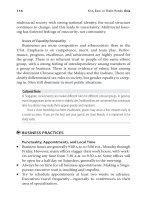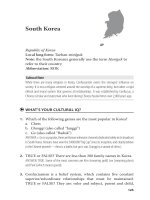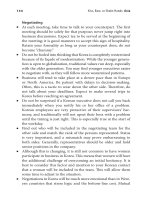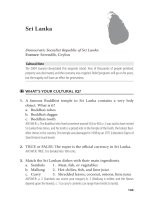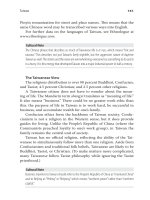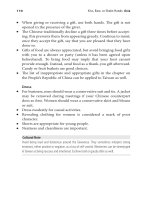Tài liệu How to Do Business in 12 Asian Countries 25 ppt
Bạn đang xem bản rút gọn của tài liệu. Xem và tải ngay bản đầy đủ của tài liệu tại đây (94.55 KB, 9 trang )
197
Appendix A
Titles and Forms of Address
in Asian Countries
T within Kiss, Bow, or Shake
Hands: Asia—single names, compound names, patronymics, names
read right to le or le to right, honorics, etc. For eciency’s sake, if
multiple countries use the same customs, we have tried to consolidate
them here. Some of this data may be repeated in certain chapters.
Chinese Naming Conventions
●
Chinese names are listed in a dierent order from Western names.
Traditionally, each person received three characters from the Chi-
nese language. e rst was the family name (from the father),
then a middle name (which used to be called a generational
name—one for all the brothers and another for all the sisters in
a family), and nally a given name—in that order. Historically,
generational names could have been planned out by a family’s
ancestors, and served a great purpose across the generations.
●
Aer the Cultural Revolution, generational names became less
common, and were supplanted by individual middle names. For
example, in 2006, the President of the People’s Republic of China
and General Secretary of the Communist Party of China, Presi-
dent Hu Jintao had the family name of Hu, a middle name of Jin,
and a given name of Tao. (His name could also be rendered Hu
Chin-t’ao.)
●
Chinese wives do not generally take their husband’s surnames,
but instead maintain their maiden names. Although Westerners
commonly address a married woman as “Mrs.” plus her husband’s
family name, it is more appropriate to call her “Madam” plus her
198
Kiss, Bow, or Shake Hands: Asia
maiden family name. For example, Liu Yongqing (female) is mar-
ried to Hu Jintao (male). While Westerners would probably call
her Mrs. Hu, she is properly addressed as Madam Liu.
●
For the sake of Western conventions, Chinese women sometimes
use their husbands’ last names.
●
Similarly, many Chinese adopt English rst names so that Eng-
lish speakers can have familiar-sounding names to identify them.
us, Chang Wu Jiang may call himself Mr. Tony Chang. Others
use their initials (Mr. T. J. Chang), which indicates that Chang
is his surname. Another way that Chinese businesspeople may
clarify their surnames is by underlining or capitalizing them in
written correspondence.
●
Chinese names can be rendered dierent ways in English, so do
not be surprised by variations. Chinese may have two names, but
more oen have three names, and the most common variant is
whether or not to hyphenate the nal two names. For example, the
rst chief executive of Hong Kong was Tung Chee Hwa. His name
could also be rendered Tung Chee-hwa, or even Tung Cheehwa.
(As with most Chinese, his surname is listed rst, so he would be
referred to as “Mr. Tung.”)
●
If many Chinese seem to have similar names, it is because there
are only about 400 dierent surnames in China! However, when
these surnames are transcribed into English, there are several
possible variations. For example, Wong, Wang, and Huang are all
English versions of the same Chinese clan name.
●
Most people you meet should be addressed with a title and their
name. If a person does not have a professional title (President,
Engineer, Doctor), simply use “Mr.” or “Madam,” “Mrs.,” or “Miss,”
plus the name.
●
e Chinese are sensitive to status, so you should use ocial
titles such as “General,” “Committee Member,” or “Bureau Chief.”
Never call anyone “Comrade” unless you are a Communist also.
Arabic Naming Conventions
●
Muslim names are usually derived from Arabic. Translating from
Arabic to other alphabets is not an exact science. Arabic names
may be spelled several dierent ways in English. For example, the
founder of the Kingdom of Saudi Arabia was King Abdul-Aziz
Al-Saud. However, his name is also rendered in English as King
Abd-al-Aziz Al Saud. History books tend to render his name as
King Ibn Saud.
●
Arabic naming traditions are used in many Islamic countries
outside of the Middle East—for example, Indonesia. In general,
names are written in the same order as English names: title, given
name, middle name (oen a patronymic), and surname (family
name). In 2005, the new ruler of Saudi Arabia was King Abdul-
lah Bin-Abd-al-Aziz al Saud; his title was “King,” his given name
was Abdullah, bin Abd-al-Aziz is a patronymic meaning “son of
Abd-Aziz,” and al-Saud was his family name. (King Abdullah suc-
ceeded the late King Fahd in August of 2005.)
●
Many Arab names have specic meanings (e.g., Amal means
“Hope”), or they are from the Bible (Ibrahiim means “Abraham”),
or they are based upon the name of God in Arabic. Abd or Abdul
are not complete names in themselves; they simply mean “ser-
vant of.” King Abdul-al-Aziz can be translated as “Servant of the
Almighty.”
●
e term bin (sometimes spelled ibn) literally means “from” in
Arabic, so it is not immediately apparent whether a name like
bin Mubarak indicates “son of Mubarak” or “from the town of
Mubarak.” However, most Saudis use it as a patronymic.
●
If an Arab’s grandfather is (or was) a famous person, he sometimes
adds his grandfather’s name. us, Dr. Mahmoud bin Sultan bin
Hamad Al Muqrin is “Dr. Mahmoud, son of Sultan, grandson of
Hamad, of the House (family) of Muqrin.”
●
Westerners frequently mistake bin for the name Ben, short for
Benjamin. Obviously, bin has no meaning by itself, and one can-
not address a Saudi as bin.
●
e female version of bin is bint. us, Princess Fatima bint
Ibrahim al-Saud is Princess “Fatima, daughter of Ibrahim, of the
house of Saud.”
●
Arabic women generally do not change their names aer they
marry.
Appendix A
199
200
Kiss, Bow, or Shake Hands: Asia
●
Another common naming convention is a given name rst, then
the father’s given name second, followed by the family name.
●
Most Saudis should be addressed by title and given name (e.g.,
Prince Khalil), just as you would address a member of the British
aristocracy (e.g., Sir John). ey can also be addressed as “Your
Excellency.” In writing, use their full name.
●
In Saudi Arabia, the title “Sheikh” (pronounced “shake”) is used
by any important leader well versed in the Koran, or an individual
worthy of great respect; it does not designate membership in the
royal family.
●
A Muslim male who has completed his pilgrimage to Mecca is
addressed as Haji. A woman who has done so would be addressed
as Hajjah. Note that these titles are not automatically conferred
on spouses; they must be individually earned by making the pil-
grimage. However, when in doubt, err on the side of generosity. It
is better to give a superuous title than to omit one.
Indian Naming Conventions
●
India’s naming conventions are changing. For example, the
southern region of India seems to be gradually moving toward
the naming customs of the north, and professional females are
starting to keep their maiden names.
●
Titles are highly valued by Indians. Always use professional titles,
such as “Professor” and “Doctor.” Do not address someone by his
or her rst name unless you are asked to do so, or you are close
friends; use “Mr.,” “Mrs.,” or “Miss.” (In Hindi, “Mr.” is Shri and
“Mrs.” is Shrimati.)
●
Status is determined by the following: age, university degrees,
caste, and profession.
●
Hindus in the Northern region of India generally have a given
name, a middle name, and a family name—written in that order.
Female siblings may share a middle name, as may male siblings.
●
Because one’s name can indicate a caste, Northern Indian families
sometimes opt to change their surnames.
●
In the southern region, naming conventions dier. Traditionally,
Hindus did not have family surnames. A Hindu Indian male may
have used the initial of his father’s name rst, or the town he came
from, followed by his own personal name. For example, V. iru-
selvan is “iruselvan, son of ‘V.’” For legal purposes, both names
would be written out with an s/o (for “son of ”) between the names:
iruselvan s/o Vijay. In either case, he would be known as Mr.
iruselvan. However, long Indian names are oen shortened. He
may prefer to be called either Mr. iru or Mr. Selvan.
●
Hindu female names follow the same pattern: father’s initial plus
personal name. When fully written out, d/o (for “daughter of”)
is used instead of s/o. When an Indian woman married, she usu-
ally ceased to use her father’s initial; instead, she followed her
personal name with her husband’s name. For instance, when S.
Kamala (female) married V. iru (male), she might go by Mrs.
Kamala iru.
●
Some Indians will use Western-style surnames. Christian Indians
may have biblical surnames like Abraham or Jacob. Indians from
the former Portuguese colony of Goa may have surnames of Por-
tuguese origin, such as Rozario or DeSilva. Such a person could
be addressed as Dr. Jacob or Mr. DeSilva.
●
Indian Sikhs generally have a given name followed by either Singh
(for men) or Kaur (for women). Always address them by a title
and rst name. While Singh literally means “lion,” to refer to a
Sikh male as Mr. Singh may be as meaningless as saying “Mr.
Man” in English.
Further data on naming conventions can be found on our Web
site, www.kissboworshakehands.com, or in Merriam Webster’s Guide
to International Business Communications.
Appendix A
201



